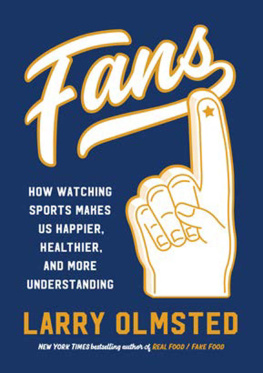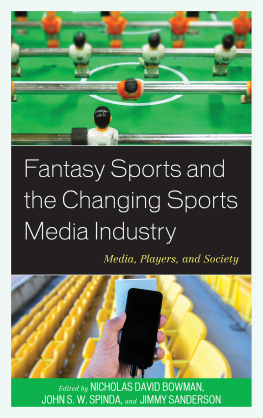American Sports in an Age of Consumption
How Commercialization Is Changing the Game
Cory Hillman

McFarland & Company, Inc., Publishers
Jefferson, North Carolina
LIBRARY OF CONGRESS CATALOGUING DATA ARE AVAILABLE
BRITISH LIBRARY CATALOGUING DATA ARE AVAILABLE
e-ISBN: 978-1-4766-2472-3
2016 Cory Hillman. All rights reserved
No part of this book may be reproduced or transmitted in any form or by any means, electronic or mechanical, including photocopying or recording, or by any information storage and retrieval system, without permission in writing from the publisher.
Front cover images 2016 iStock/Shutterstock
McFarland & Company, Inc., Publishers
Box 611, Jefferson, North Carolina 28640
www.mcfarlandpub.com
Acknowledgments
This book would not have been possible without the help and support of several people I wish to thank here. First, my thanks go to my wife, Abigail, and my stepchildren, Damion and Destiny, for their love and understanding throughout this arduous process. It could not have been easy given the time this book consumed in my daily life, but I will make up for it. I would also like to send a special thanks to my parents, Bob and Lee Ann Hillman, for their unconditional love and support throughout my life and for always being there when I need them. Thanks to my brothers, Chad and Chris Hillman, as well as to my sisters-in-law, Heather and Lori, my nephews, Landon and Brynn, and my uncle Chuck, my uncle Ken and my aunt Karen as well as to my cousins Olivia and Austin Hillman. I need to also thank my dissertation advisors Clayton Rosati, Josh Atkinson, and Dave Tobar, whose insights uniquely contributed to this book. And, of course, I would like to send a special thanks to Michael Butterworth, my dissertation advisor, whose wisdom was most responsible for this work and for whom I have the utmost respect as both an academic and a person. Thanks to my good friends Matt Lamb, Bryan Bohn, Ryan Anderson, John-Paul Staszel, Jacob Turner and Bruce Lillie for helping me survive graduate school and for sharing many of the good times we had. I would also like to thank Matt Maier and Brion White, my office mates while I was a doctoral student at Bowling Green State University, for the many laughs, insights, and conversations we shared as we occupied the bottom floor of West Hall together. And, finally, I want to thank all of the staff in the Communication and Dramatic Arts Department at Central Michigan University for believing in me enough to hire me and for believing in me enough to keep bringing me back.
Preface
This book began in the spring of 2009 when I was a doctoral student in the Media and Communication Department at Bowling Green State University. I was taking a class taught by Dr. Michael Butterworth titled Sports and Resistance in which we discussed how sports have served as a site of political struggle in the United States and abroad. After finishing the course, I decided to specialize my research in the emerging area of communication and sport, not only because it captured many of my interests and concerns but also because of what was happening in Detroit. In 2008, the city began dismantling historic Tiger Stadium, which, with few exceptions, had sat empty since the Tigers played their last game there in 1999. After watching YouTube videos of construction crews demolishing the all-too-familiar confines of my baseball-loving youth, I became sad because of what the stadium had meant to me personally. I was not alone.
I remember attending my first major league baseball game at Tiger Stadium when I was seven years old with my father, Bob, my two brothers, Chad and Chris, and my uncle Chuck on August 24, 1986. The fact that I even remember the exact date testifies to how important this was for me. Aside from that, I remember only a few disconnected fragments and moments from the game itself. We sat in the upper deck in left field where we watched an old timers game before the Tigers were set to take on the Seattle Mariners. Hall of Fame pitcher Warren Spahn chatted with Tigers manager Sparky Anderson before the exhibition in his old, dusty, baggy Milwaukee Braves uniform. Tigers outfielder Larry Herndon slapped a broken bat chopper up the middle that struck Mariners pitcher Mark Langston in the throat. Unfortunately, I also recall that the Tigers lost, although I dont remember exactly what the score was. Years later, I would attend more games at Tiger Stadium with my family, my Little League team, and even some of my teammates on the Saginaw Valley State University baseball team. As I watched the videos chronicling Tiger Stadiums destruction online, I felt I was losing an important connection to my past that the park had symbolized. In short, it felt much like a funeral. My experience was common among devoted Tigers fans who, in the various accounts that I read and watched on the Internet, discussed their personal memories of the famed ballpark as if they were mourning the passing of an old friend. Because of this, I wanted to understand why sports stadiums could evoke such emotional responses and why they were rapidly being replaced in the larger sporting landscape.
Thus, I decided to do research on what ballparks, stadiums, and arenas symbolized about our culture in both the past and the contemporary moment as historic venues were being torn down in favor of modern corporatized substitutes. Why was it that seemingly every team owner wanted a domed stadium during the 1970s and 1980s only to insist that these venues were obsolete by the 1990s? Did it, perhaps, have anything to do with the shifting social and economic values within the larger culture at the time that now considered any kind of history disposable if it served as a barrier to profit? But this work had already been done. So I focused my efforts on how the growing commercialization of sports both reflected and shaped a culture defined by consumerism. Furthermore, I was interested in how these trends were redefining both the meaning of sports and the ways that fans were expected to relate them. In short, it was becoming apparent that as sports were increasingly serving as a vehicle to sell the products of their commercial sponsors, their essential meaning was being lost.
Of course, this is not to say that a pre-commercial era of sports has ever existed, because this is simply not the case. Team owners and other institutional players have always conceived of them as a business designed to turn a profit. However, it is clear that sporting commercialization operates within fewer barriers and limits than it has historically. Commercial sponsors have taken center stage within ballparks, stadiums, and arenas as well as televised sport in a manner barely overshadowed by the action taking place on the field, court or ice. Thus, when one watches sports, whether in person or on television, they are pressured to engage the same market forces all too dominant in our culture as they are encouraged to increasingly embody the role of the consumer. This book seeks to understand what kinds of messages fans encounter in their relationship with sports and the effects of those messages and to contextualize these communication processes within dynamics occurring in our social and political environment. This is not to suggest that commercialization has no role in sports, but rather too much of it tends to render them hallow and superficial as the entire fan experience of sports is being redirected toward serving corporate capitalism. Sports, thus, serve as a reminder of the degree to which the market is everywhere and how its logic determines contemporary social values and, ultimately, our political character itself.











